|
click on images to enlarge
NIELLO SILVER FROM VIENNA
In this page I present two pieces made in late 19th
century in Austria.
NIELLO SILVER MATCH SAFE (1872-1878)
The front cartouche has a monogram AH below the inscription
KLOBUK (Klobuk is a village in a municipality of
Ljubuski, Bosnia and
Herzegovina) and a date 27/9 1878.
Dimensions 65 x 25 x 17 mm, weight 26,3 grams.
Austrian Silver 900 mark for Vienna post 1872 (Diana head
hexagonal lozenge with 2 and A) letter A and maker's mark M & S
for Markowitsch & Scheid (1862-1881).
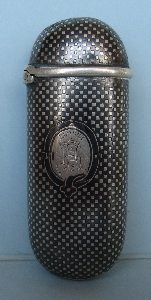
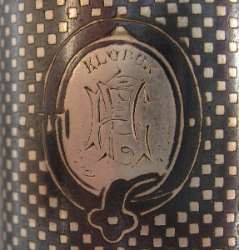
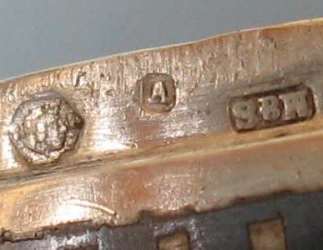 |
Niello silver match safe: Markowitsch &
Scheid (1862-1881)
|
NIELLO SILVER CIGARETTE CASE (1882-1922).
The cartouche is engraved with a monogram.
Dimensions 94 x 57 x 16 mm, weight 85 grams.
The inside bears the makers mark "G.A.S." (George Adam Scheid)
and the hexagonal lozenge mark with Diana head and a "2" and an
"A" (Austrian silver mark for 900/1000 purity silver plus assay
for Vienna after 1872).
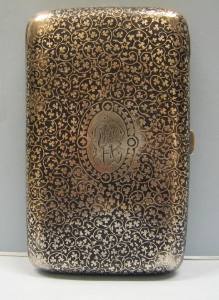
 |
Niello silver cigarette case: George Adam
Scheid
|
BIOGRAPHY OF GEORG ADAM SCHEID (1837-1921)
Georg Adam Scheid was born in Schönau Baden,
Württemberg on July 28 1837. He started his
apprenticeship in 1853 and operated afterwards in
Pforzheim and Stuttgart. In 1858 he came to Vienna
and entered the workshop of the gold, silver goods
producer and jeweler Michael Markowitsch. He married
one of Markowitsch's daughters and in 1862 the
company was renamed Markowitsch & Scheid and adopted
the mark M & S. It was located in Sandwirtgasse 8,
and then in Gumpendorfer Straße 83.
(right) Josef Maria Auchentaller: Portrait of the father-in-law G. A. Scheid 1891
(http://www.auchentaller-art.com/werwar/werwar/muenchen.html)
|
 |
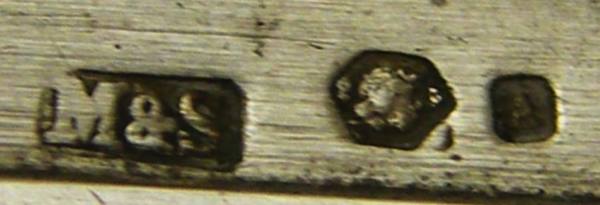 |
Maker's mark M&S for Markowitsch & Scheid
(1862-1881) or Markowitsch & Son (1882-1898)
|
In 1882 they separated and Sheid started his own flourishing
operation, employing up to 300 workers. The silver decoration
factory was named "G. A. Sheid" and used different marks. It was
located in Gumpendorfer Straße 85 ( http://www.beyars.com/lexikon/lexikon_970.html
).
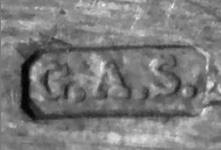
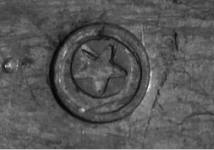
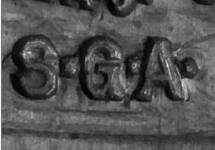
|
Georg Adam Scheid mark (from
http://www.silvercollection.it/austriansilverhallmarks.html)
|

|

|


|



|
Several of Georg Adam Scheid marks, many with
import marks for Germany
|
Markowitsch & Scheid was then owned by Adolf Markowitsch
alone, a son of Michael Markowitsch, and kept the same mark, the
company shut down in 1898.
Specialities of Sheid's factory were cigarette cases, powder
boxes, write sets, toilet sets as well as jewelry boxes, which
were also sold in large quantities in Germany, France, Italy,
Great Britain, Belgium and Spain.
To ensure the supply of raw materials in 1888 Scheid opened
up his own refinery where,
from precious metal wastes, raw material as well as
semi-manufactured products, as sheet metals and wires were produced.
The operation grew rapidly and covered not only his own
requirement but goods were also exported abroad and with the establishment
of sister operations in Budapest (1891), Prague (1920) and
Bucharest (1923) Scheid took control of the market.
In 1894 the sons Arthur (1870-1897) and Robert (1872-1950), as
well as his nephew George (1850-1937), stepped in as partners.
In 1911 George Adam Sheid withdrew from the business life and
Robert and Georg Sheid took over. Robert and his younger brother
Ludwig (1886-1960) then assumed the management.
After the First World War, fall of the overseas market for the
decoration sector and the bad economic situation led, as a
consequence, to the liquidation of the decoration factory, while
the "Affinerie" continued and in 1962 merged with the Ludwig
Roessler GmbH to form the ÖGUSSA GmbH, which still exists today
(http://www.oegussa.at/).
The most famous works of Scheid are related to the Austrian
secessionist movement and took advantage of the collaboration
with famous artists such as
Koloman Moser (1868-1918) (http://www.koloman-moser.com/),
Josef Hoffmann (1870-1956)
(http://www.josef-hoffmann-handicraft.com/)
Josef Maria Auchentaller (1865-1949)
(http://www.archimagazine.com/bauchentaller.htm)
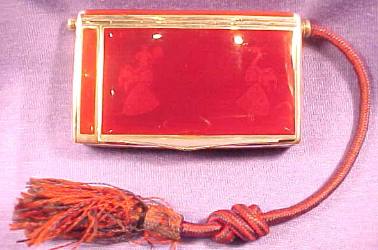 |
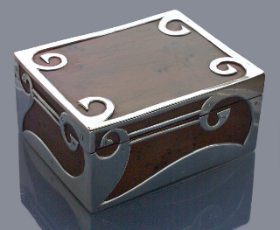 |
Red Enameled Cigarette Case with
built-in Vesta
(http://www.matchsafe.org/pmse-
022_red_enameled_cigarette_case_with_vesta.htm)
|
Georg Adam Scheid Vienna
Secession Box
(Josef Maria Auchentaller 1865-1949,
Attrib.)
(http://www.tademagallery.com/content.htm)
|
Georg Adam Scheid died on April 3 1921 in
Meran and is buried in the family tomb at the
Evangelischer Friedhof Simmering, Simmeringer
Hauptstraße 242, 1110
Wien. (http://www.evangelischerfriedhof11.at/promi_graeber/scheid.html).
|
 |
Finally, to better understand the personality of the artist,
it is worth mentioning the very recent rediscovery of Sheid's
villa in Vienna that was thought to be lost forever.
Sheid had the villa commissioned and built in 1896 by the famous
architect Joseph Hackhofer
(http://www.waymarking.com/waymarks/WM7TM6_Vienna_River_Portals_in_Stadtpark_Vienna_Austria)
and the interiors were decorated by Auchentaller. As a matter of
fact Sheid was the father-in-law of both Auchentaller and
Hackhofer. Another of Sheid's daughters, Martha, was married to
Viktor Thonet, an exponent of the famous dynasty of bentwood
furniture manufacturers, who later acquired the paintings
Auchentaller had made in 1898/99 for the music room in Villa
Scheid, which were inspired by Pastorale, Beethoven's sixth
symphony.
One of the paintings by Auchentaller for the villa Music Room,
the "Elfenreigen" (Elves dance) actually depicts the five young
daughters of G. A. Scheid. The villa, restored, now houses the
Embassy of the Republic of Korea at Gregor Mendel Strasse 25.
(http://www.auchentaller-art.com/new_discoveries/new.html).
Georg Adam Sheid was therefore not only a great artist, but also a very successful businessman
and an influential figure of the Viennese society in the golden age of the Austro-Hungarian
Empire at the end of the 19th century,
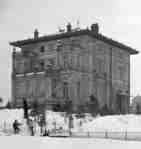
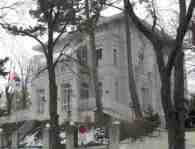
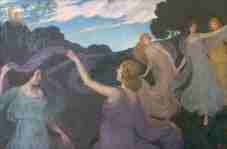
|
(left) Villa Scheid in the Winter,
around 1898
(center) Embassy of Korea, 2010
(right) Auchentaller's painting: "Elfenreigen"
(detail)
for the Music Room in the Villa Scheid, around
1898/99.
The five dancing girls are actually the five
young daughters of
Georg Adam Scheid. Martha Scheid (later Thonet) is
third
from the right (with red hair), Emma Scheid, the
wife of
Auchentaller himself, is second from left
|
|

